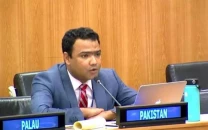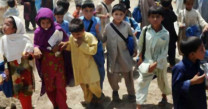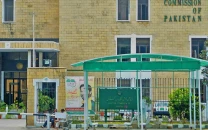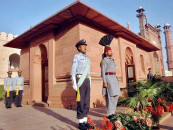Painting exhibition: On an inspired, spirited spree
Komail Aijazuddin makes a bold statement with his first show in capital.

The Islamic geometric patterns in the paintings have been taken from sites and shrines in or around the country, such as Thatta in Sindh and Wazir Khan’s Mosque in Lahore. PHOTO: MYRA IQBAL/EXPRESS
A glance at Komail Aijazuddin’s work and one is overpowered by the contrast of red, gold and black and the intricacies within. The visual artist displayed a collection of his no-holds-barred paintings, “Red and Gold” at the newly-renovated Khaas Art Gallery on Tuesday.
Aijazuddin’s work is as risqué as it is experimental. The series is nuanced with symbols, cultures and iconographies where the artist has explored divine connections, theocratic morality, human frailty, longing amidst abundance and judgment, among other themes.
The Islamic geometric patterns in the paintings have been taken from sites and shrines in or around the country, such as Thatta in Sindh and Wazir Khan’s Mosque in Lahore. The painting, “Durga Hijaban” is a play on iconographies to Hindu images and traditions.
The largest piece, “State of Affairs”, draws in the viewer for its traditional feel, mockery of established norms and varied aesthetic. According to the artist, he wanted to use indigenous architecture, a caved Mughal-esque balcony to create a new kind of altar. “Though monumental in size, it is a personal piece about my own time in this country,” he said.
He said the use of red in the paintings was accidental. “I began using it years ago, as per medieval instructions, to give the gold leaf in my work a warmer tint.
The patience, precision and planning that the combination requires of me is the closest I get to meditation,” he said. Nearly all of his work involves oil paint and mixed media.
This was the first time the artist displayed a show using this series of work. Previously, many of his paintings and altarpieces had been rooted in specific stories, events and narratives from early Islam.
Commenting on the show, art student Alina Akbar said, “I found the black splashes on one of the pieces to be very chaotic, even though they do add to the controversial theme. Also, the composition is nicely done.”
Meanwhile, architect and artist Faizaan Ahab dubbed the collection a universal address. “The work is very realistically modern. The colour palette is intense and the divine approach has been dealt with in an eclectic manner. What really stood out for me was the juxtaposition of the Islamic Arabesque, the Christian Halo and the Indian Deity. I’m overwhelmed,” he said.
Zainab Omar, the owner of Me Art World online gallery, said she had been following Aijazuddin’s work for a long time. “I’ve bought some of his work from the Bonham Auction House in London and have seen him progress as an artist over the years. Initially, his work was influenced by the Renaissance, but with time, he has found his own style and interpretation,” she said.
Musician Adil Omar said he was a big fan of Aijazuddin’s work. From the current collection, Omar particularly likes “State of Affairs” and “Crown” because of the biblical imagery used in both of the pieces.
Argentinean Ambassador Rodolfo J. Martin Saravia found the paintings powerful and intense, adding they were a bridge between the Eastern and Western cultures.
“It is refreshing to see how the artist has created something new with each individual piece while using the same colours and geometric patterns. However, I do feel the pieces are expensive and should be sold on half-price,” said Parvaiz Ahmed, a guest at the exhibition.
Published in The Express Tribune, September 19th, 2013.



















COMMENTS
Comments are moderated and generally will be posted if they are on-topic and not abusive.
For more information, please see our Comments FAQ